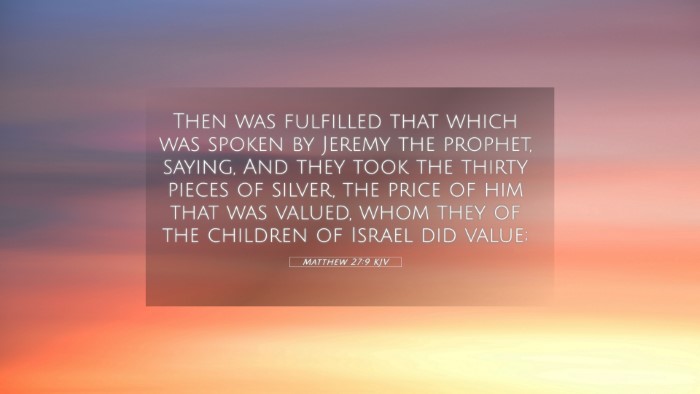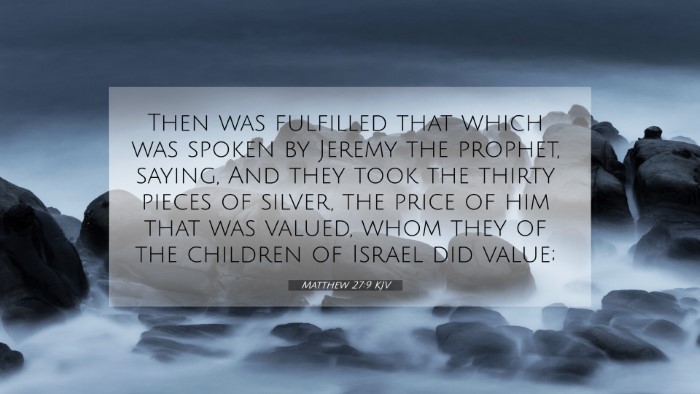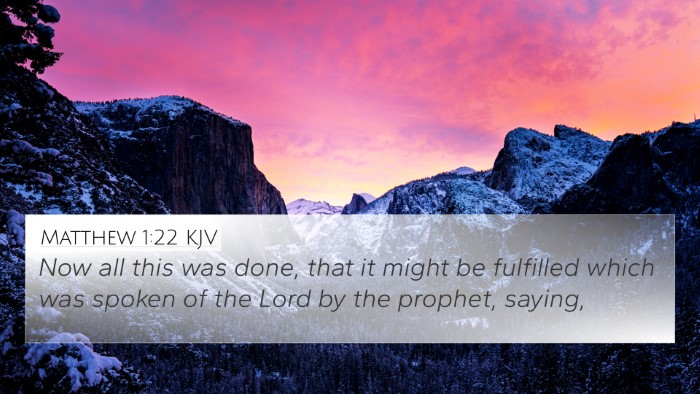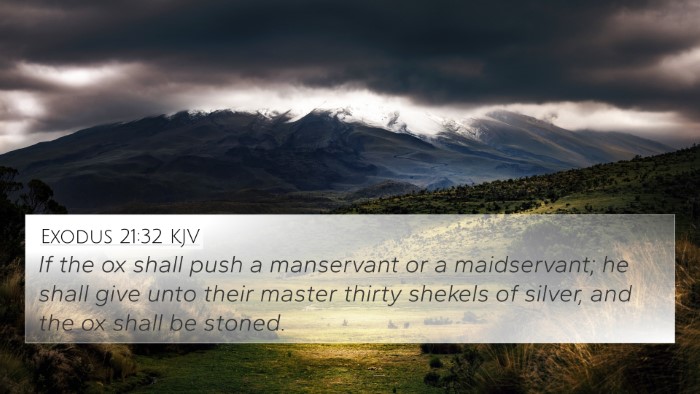Understanding Matthew 27:9 - A Commentary Analysis
Bible Verse: Matthew 27:9 - "Then was fulfilled that which was spoken by Jeremy the prophet, saying, And they took the thirty pieces of silver, the price of him that was valued, whom they of the children of Israel did value."
Contextual Background: This verse occurs during the trial and subsequent condemnation of Jesus, highlighting the fulfillment of Old Testament prophecy. Specifically, it refers to events surrounding the betrayal of Jesus by Judas Iscariot, who sold his Lord for thirty pieces of silver.
Summary of Insights from Public Domain Commentaries
The insights derived from commentaries such as those by Matthew Henry, Albert Barnes, and Adam Clarke enrich our understanding of this pivotal moment in Scripture.
Matthew Henry's Commentary Insights:
Henry emphasizes the prophetic nature of this scripture. He notes that the phrase "then was fulfilled" indicates a direct connection between prophecy and its historical realization. The thirty pieces of silver symbolize the value placed on Jesus by those who betrayed Him, reflecting malice and materialism within the human heart. Henry also ties this act of betrayal to the broader theme of redemption, highlighting that Jesus’ sacrifice was preordained and essential for the atonement of humanity.
Albert Barnes' Commentary Insights:
Barnes adds that the reference to "Jeremy the prophet" originally stems from Zechariah 11:12-13, though the quotation itself may not be directly from Jeremiah. He underlines the significance of the specific amount of money and correlates it with ancient customs. Special attention is given to the fulfillment of prophecy, illustrating God's sovereignty and meticulous orchestration of events leading to the crucifixion of Christ.
Adam Clarke's Commentary Insights:
Clarke provides detailed analysis on the prophetic implications of the thirty pieces of silver, analyzing its reference to both the love of money and the treachery involved in Judas's betrayal. He draws parallels between this act and various Old Testament scriptures, reinforcing the scriptural truth that God's plans cannot be thwarted by human actions or intentions. Clarke emphasizes that the fulfillment of this prophecy serves as a confirmation of Christ's divine mission and purpose.
Related Cross References and Thematic Connections
This verse not only serves as a standalone piece of Scripture but also links to other passages that illuminate similar themes of betrayal, prophecy, and redemption. Here are key biblical cross-references:
- Zechariah 11:12-13: The prophecy regarding the thirty pieces of silver.
- Judas' betrayal in Matthew 26:14-16: The transaction of selling Jesus for silver.
- Acts 1:18: Discusses the fate of Judas after the betrayal.
- Psalm 41:9: Touches upon the betrayal by a close friend.
- Isaiah 53:3: Foretelling Jesus being despised and rejected.
- John 13:18-19: Jesus referencing Psalm 41 regarding betrayal.
- Matthew 1:22-23: Alludes to prophecy fulfillment through Christ’s life.
- 1 Peter 1:20: Discusses the foreknowledge of Christ’s sacrifice.
- Luke 22:48: Jesus addresses Judas during the betrayal.
- Hebrews 10:7: Explains Christ's willingness to fulfill God’s plan.
The Thematic Connection Across Scriptures
The connections between these passages provide a richer understanding of the Scriptural narrative. Thematic insights can be drawn particularly around the ideas of:
- Prophecy and Fulfillment: The occurrence of Old Testament prophecies being quoted and revisited in New Testament contexts.
- Betrayal and Redemption: The dichotomy of human betrayal contrasted with divine redemption plans.
- Sovereignty of God: The assurance that God’s plan prevails despite human actions and decisions.
Conclusion
In summary, Matthew 27:9 represents a crucial link in understanding the events leading to Jesus' crucifixion and the fulfillment of prophetic words about the Messiah. By integrating insights from trusted commentaries and drawing connections through cross-references, one can achieve a comprehensive view of the scriptures and their interrelated nature. This analysis not only enhances our study of the Bible but also serves as a resource for anyone seeking deeper understanding of the connections between its verses.
Tools for Further Study and Cross-Referencing
For anyone wishing to delve deeper into the intricate web of biblical connections, consider employing the following tools:
- Bible concordance: A valuable tool for locating specific words and themes across biblical texts.
- Bible cross-reference guide: A system that lists relevant verses associated with the primary scripture.
- Cross-reference Bible study: Methodologies for examining Scripture in a relational context.
- Bible reference resources: Books and materials designed to facilitate in-depth scripture analysis.
Understanding these connections not only aids in personal study but also enhances the ability to prepare sermons and teachings around biblical themes.







